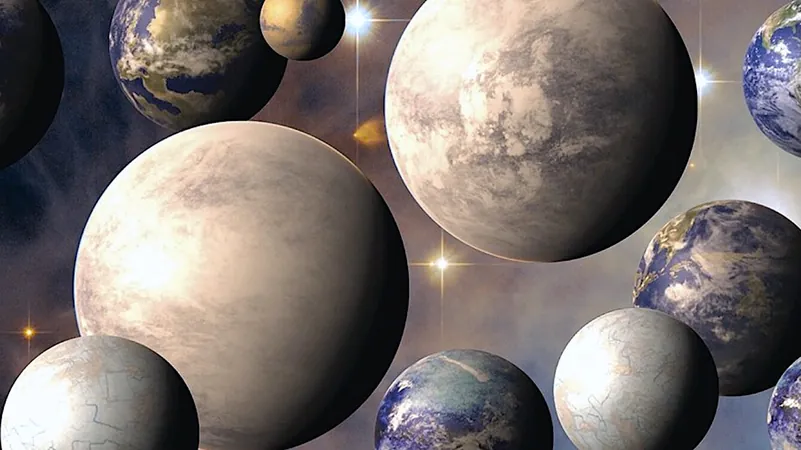
Groundbreaking Study Unveils the Secrets Behind Super-Earths and Mini-Neptunes
2025-03-25
Author: Nur
Introduction
A revolutionary study led by researchers Sho Shibata and Andre Izidoro from Rice University proposes a new model for explaining the formation of super-Earths and mini-Neptunes, two types of exoplanets that are 1 to 4 times the size of Earth and are among the most prevalent in our galaxy. Their findings, published in The Astrophysical Journal Letters, could significantly reshape our understanding of planetary evolution beyond our solar system.
Traditional Models of Planet Formation
For many years, scientists have grappled with the origins of these intriguing planets, with traditional models suggesting that planetesimals—the tiny building blocks of planets—form across expansive areas of a young star’s disk. However, Shibata and Izidoro introduce a bold new concept: these planetesimals may coalesce in narrow rings at specific sites within the disk, indicating a more organized and systematic approach to planet formation than previously envisioned.
Significance of the Research
"This research is especially significant as it delves deep into the formation processes of super-Earths and mini-Neptunes, which appear to be the most common planetary types in our galaxy," stated Shibata, a postdoctoral fellow in Earth, Environmental, and Planetary Sciences. He emphasized that one of their key conclusions is that the formation pathways of our solar system may mirror those of exoplanetary systems.
Advanced Simulations Used in the Study
Employing advanced N-body simulations—computer models designed to track how celestial bodies interact through gravity—the researchers investigated planet formation in two distinct domains: one within 1.5 astronomical units (AU) of the host star and another beyond 5 AU, near the water snowline. These simulations meticulously followed the interactions, collisions, growth, and migration of planetesimals over millions of years, revealing that super-Earths form primarily through planetesimal accretion in the inner disk, while mini-Neptunes develop beyond the snow line, mainly via pebble accretion processes.
Findings on Planet Formation
"Our findings indicate that super-Earths and mini-Neptunes do not originate from a continuous spread of solid materials but rather from stacked rings where most solid mass is concentrated," Izidoro, an assistant professor at the university, elaborated. The elegant nature of their ring model successfully accounts for the peculiar “radius valley” observed in exoplanetary systems—a striking shortage of planets around 1.8 times Earth’s size. Instead, planets in these systems generally cluster into two distinct size categories: approximately 1.4 and 2.4 times the size of Earth. This model provides a plausible explanation for the observed gap by suggesting that planets smaller than 1.8 times Earth’s radius are mainly rocky super-Earths, while those larger are water-rich mini-Neptunes.
Understanding Multiplanet Systems
Moreover, the research sheds light on the homogeneity frequently witnessed in multiplanet systems, where multiple planets exhibit strikingly similar sizes. The ring model contributes to this uniformity by controlling the growth and formation processes within each ring, ensuring a cohesive size configuration among planets in close proximity.
Correlation with Planetary Orbits
The simulations conducted also correlate with existing data regarding planetary orbits, reinforcing the notion that planets develop from defined locations rather than being randomly scattered throughout the disk.
Future Predictions and Implications
Looking towards the future, this innovative model not only clarifies existing observations but also holds promise for predictive analysis regarding planetary formation. Izidoro notes that while it may be rare, the formation of rocky planets in a planet’s habitable zone could occur as a result of late-stage giant collisions, akin to the one that created Earth and its moon.
"Our model empowers us to make predictions about the types of planets that could exist at Earth-sun equivalent distances—regions currently beyond the observational reach," he added. "Based on our calculations, around 1% of super-Earth and mini-Neptune systems may contain Earth-like planets within the habitable zone of their stars, suggesting the occurrence of about one Earth-like planet for every 300 sun-like stars. This is a tantalizing prospect given the abundance of these super-Earths and mini-Neptunes."
Conclusion and Future Research
The implications of this research for future exoplanet studies are profound. "Our predictions will be rigorously tested with upcoming telescopes, which will provide essential insights into planetary formation and potential habitability," Shibata concluded. "If our predictions are validated by future observations, the implications could dramatically alter our understanding of planetary formation—not just in our galaxy, but across the vast universe itself."
This groundbreaking work opens a new chapter in the exploration of planetary science, and the quest to uncover Earth-like worlds in the cosmos may be entering an exhilarating new phase.


 Brasil (PT)
Brasil (PT)
 Canada (EN)
Canada (EN)
 Chile (ES)
Chile (ES)
 Česko (CS)
Česko (CS)
 대한민국 (KO)
대한민국 (KO)
 España (ES)
España (ES)
 France (FR)
France (FR)
 Hong Kong (EN)
Hong Kong (EN)
 Italia (IT)
Italia (IT)
 日本 (JA)
日本 (JA)
 Magyarország (HU)
Magyarország (HU)
 Norge (NO)
Norge (NO)
 Polska (PL)
Polska (PL)
 Schweiz (DE)
Schweiz (DE)
 Singapore (EN)
Singapore (EN)
 Sverige (SV)
Sverige (SV)
 Suomi (FI)
Suomi (FI)
 Türkiye (TR)
Türkiye (TR)
 الإمارات العربية المتحدة (AR)
الإمارات العربية المتحدة (AR)